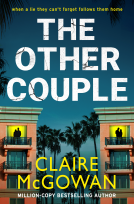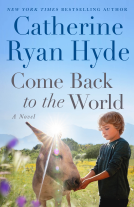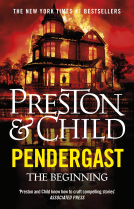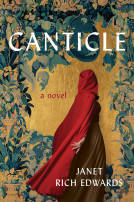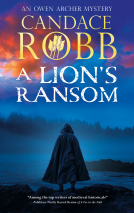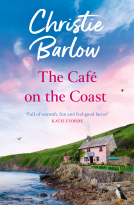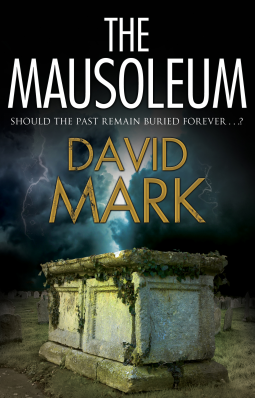
Mausoleum, The
by David Mark
This title was previously available on NetGalley and is now archived.
Send NetGalley books directly to your Kindle or Kindle app
1
To read on a Kindle or Kindle app, please add kindle@netgalley.com as an approved email address to receive files in your Amazon account. Click here for step-by-step instructions.
2
Also find your Kindle email address within your Amazon account, and enter it here.
Pub Date 1 Jun 2019 | Archive Date 31 May 2019
Talking about this book? Use #TheMausoleum #NetGalley. More hashtag tips!
Description
1967. In a quiet village in the wild lands of the Scottish borders, disgraced academic Cordelia Hemlock is trying to put her life back together. Grieving the loss of her son, she seeks out the company of the dead, taking comfort amid the ancient headstones and crypts of the local churchyard. When lightning strikes a tumbledown tomb, she glimpses a corpse that doesn’t belong among the crumbling bones. But when the storm passes and the body vanishes, the authorities refuse to believe the claims of a hysterical ‘outsider’.
Teaming up with a reluctant witness, local woman Felicity Goose, Cordelia’s enquiries all lead back to a former POW camp that was set up in the village during the Second World War. But not all Gilsland’s residents welcome the two young women’s interference. There are those who believe the village’s secrets should remain buried … whatever the cost.
Available Editions
| EDITION | Other Format |
| ISBN | 9780727888723 |
| PRICE | US$28.99 (USD) |
| PAGES | 304 |
Average rating from 33 members
Featured Reviews
 Hannelore C, Reviewer
Hannelore C, Reviewer
Thank you NetGalley and Severn House for the eARC.
THE MAUSOLEUM is one of my favorite books of the year so far, what a terrific read!
Cordelia Hemlock and Felicity (Flick) Goose are at the bedside of a dying man. The year is 2010 and the women are trying to wake the man to question him.
We then go back to 1967 when the two young women meet at a cemetery under odd circumstances and end up becoming great friends.
When they walk home during a torrential downpour lighting strikes a mausoleum during which they spy a body. A neighbor decides to go check it out, but is killed whole driving through the storm and the body has mysteriously disappeared.
Cordelia, in deep mourning after her 2-year old beloved son's death, finds some solace in trying to ferret out the disappearance of the dead man and both she and Flick start investigating. The secrets they stir up go back to WWII and uncover a hornet's nest of lies, cruelty and betrayal.
I loved both women and the story is told by both of them in alternate chapters. Their characters are very different, but they are a good fit. There are some very graphic passages of the torture by the Nazis and their French helpers, and then there's the shadowy world of espionage that makes one question how much we should condone, pardon and employ perpetrators for the sake of king and country.
This is a terrific book, beautifully written and with a strong sense of place. Highly recommended!
 J. Aislynn d, Reviewer
J. Aislynn d, Reviewer
‘1967. In a quiet village in the wild lands of the Scottish borders, disgraced academic Cordelia Hemlock is trying to put her life back together. Grieving the loss of her son, she seeks out the company of the dead, taking comfort amid the ancient headstones and crypts of the local churchyard. When lightning strikes a tumbledown tomb, she glimpses a corpse that doesn’t belong among the crumbling bones. But when the storm passes and the body vanishes, the authorities refuse to believe the claims of a hysterical ‘outsider’. Teaming up with a reluctant witness, local woman Felicity Goose, Cordelia’s enquiries all lead back to a former POW camp that was set up in the village during the Second World War. But not all Gilsland’s residents welcome the two young women’s interference. There are those who believe the village’s secrets should remain buried … whatever the cost.’
The Mausoleum by David Mark takes place mostly in 1967. Cordelia Hemlock has just lost her young son to illness. She's taken to finding odd places to sit and read, to remember, to mourn. Cordelia lives in remote Gilsland and has yet to bond with any of the locals. One day, Cordy startles Felicity Goose who stumbles across her as Cordelia is resting among the gravestones of the little church cemetery. The two begin to talk, and when it starts to storm, Felicity invites Cordelia back to her own cottage, which is closer. Before they can even clear the cemetery, the storm worsens, spitting lightning. One bolt hits a dead tree and topples into a mausoleum, breaking it open. And there, amidst the rubble, lies a fresh body only days old. Thus begins the friendship of Cordelia Hemlock and Felicity Goose.
The two women, pluckier than they seem at first, begin to dig into the corpse's mysterious appearance after they tell Felicity's neighbor, Fairfax who then dies in a car accident after he rushes out in the storm to locate the body and alert the constable. The fresh mausoleum corpse vanishes, leaving few clues behind. Fairfax's home lends a few more clues, harkening back to a terrible war-time atrocity and governmental devil's deals. This mystery and its unfortunate aftermath give Cordelia something to focus on to let her grief over her son begin to soften and heal.
I adore Cordy and Flick! They each helped t'other to grow and learn. Both women had steel underneath, that began to show through more and more. They each still have vulnerability though, and I love how at times Felicity's pragmatic country nature takes over, leading her to treat Cordelia as a daughter, or younger sister. Likewise, there are times Cordelia treats Flick as a sister. Despite the circumstances, or as like as naught because of them, they develop a close friendship that lasts decades. Each grows over the course of the story, especially Cordelia. She ends up with a pretty sweet job from the whole affair! I'd love to read about her further adventures.
I would have loved to have interacted more with Fairfax. He was a gentleman after my own heart, with his interest in writing. He was quite the historian! As for other secondary characters, I liked John, Felicity's husband. I think I could have liked her son James too, but we didn't get to see him as much as his brother Brian. I'd love to have gotten an explanation over James’ notebook, but we don't get final follow-up with him, and there's not enough page time with him for me to gauge personality. If he was supposed to be a foil to Brian, it didn't work for me. He was easy to overlook. Brian, on the other hand, was a pita, and needed his ass tanned.
I really enjoyed the slow unraveling of the mystery. It was less suspense/thriller, and more a historical investigation. Through Fairfax's papers, and Cordy and Flick's persistent research, we get to learn about events that happened during World war II, and there were some surprising revelations toward the end. Thinking back, I see the hints, but it really stunned me at first. Overall, a great read! If you enjoy historical mysteries, be sure to check it out!
***Many thanks to Netgalley/ Severn House for providing an ecopy in exchange for a fair and honest review. Reviewed for Love Books Tours
4 stars
This story is an unusual one.
It is 1967 and Cordelia Hemlock is still grieving the loss of her two-year old son. She is lying in a graveyard when Felicity Goose happens upon her. (Aren't those great character names?) At first Cordelia is distrusting but then the women become fast friends. While they are talking and trying to run from an oncoming storm, a lightning strike hits a mausoleum. The women see a body that does not belong in the graveyard.
The body then disappears. A neighbor and local historian Fairfax says he will investigate, but his car crashes on the way to view the site. He is killed. The women decide to look into the mystery themselves. They are, on the surface, very different women but become close. They share their burdens, Cordelia a little more reluctantly than Felicity. Felicity is patient, while Cordelia is not. Cordelia is educated, but she learns much from Felicity.
What they discover is that the mystery goes back to World War II. Fairfax has written down the words of a man who tells him his story of what occurred to him during WW II. He describes the torture and cruelty of the Nazi Gestapo and the French Milice that went on and was horrendous. He called the man “Abel.” Is this the man whose body the women saw?
This book is told from both Cordelia and Felicty's points of view using the accents the women would have spoken. I appreciated the way Mr. Mark was able to switch back and forth to give the two women their own voices. This is a well written and plotted novel that switches back and forth between 1967 and 2010.
I want to thank NetGalley and Severn House/Severn House Publishers for forwarding to me a copy of this interesting and very good story for me to read, enjoy and review.
 Puzzle D, Reviewer
Puzzle D, Reviewer
1967, a small village in the Scottish Highlands, and a local woman, Felicity Goose, discovers Cordelia Hemlock, lying in an open grave. Cordelia is grieving for the loss of her son, but soon the two women begin to bond, primarily due to discovering a dead body. A lightning strike breaks open a mausoleum, revealing a fresh body inside. But when they tell a friend about it, not only does that friend die in a car crash, but the body vanishes to.
The truth behind the deaths reaches back to the War, to the atrocities committed in the name of patriotism. It seems that not all crimes were paid for in full. And some people have very long memories…
What’s that, I hear you cry? You’re desperate to know how The Creeping Jenny Mystery review ends? Well, so am I, but yesterday I was at the Third Section Regional Brass Band competition. Basically, each band plays the same ten-minute piece of music which to those with well-tuned musical ears is a fascinating experience, spotting the subtle errors (and some not-so-subtle) errors that each band commits. But to those with less well-tuned ears will need something to help pass the time, but a valuable near ninety-year old first edition is a bit tricky to sneak in. A Kindle, however, is a different matter…
You’ll recall David Mark as the author of the Aector McEvoy mysteries, but this is a standalone mystery. Actually, it might be the start of a series, as the book opens with a prologue with Cordelia and Felicity in the present day, and the epilogue of the same setting reveals that there have been significant changes in their lives. But this book stands perfectly well by itself.
It’s as one might expect if you’ve read the McEvoy mysteries, a deep and complex tale, full of twists that change the reader’s expectations of where the story is going. It’s a rewarding read, and while not a classic whodunit, is still full of surprises and, in addition, characters that you care about. Definitely well worth your time.
The Mausoleum was a great historical/current day mystery. The writing and characters are fantastic in this book. This story will pull you in until the last page.
 Jeff P, Media/Journalist
Jeff P, Media/Journalist
The Mausoleum is a slightly unusual crime novel and quite a change for David Mark, who is best known for his DS McAvoy series of police procedurals.
The book opens in 2010 with two old ladies watching an even older man nearing death in a hospital bed. They harshly wake him so that he can answer their questions. The book then moves back to 1967 when the two ladies first meet over a grave in a small village near the Scottish border. Cordelia Hemlock is trying to pull her life back together after a failed academic career, a marriage of convenience and the death of her young son. She is an outsider in the ‘lost in time’ village of Upper Denton and is initially dismissive of the quiet, submissive, uneducated Felicity Goose. Their first meeting is interrupted by a sudden violent storm and a lightning strike which reveals a recently deceased body in a mausoleum hundreds of years old. When the storm passes, they find that the body has disappeared and that the one person they told about the body has died in a suspicious car accident. Together they decide to investigate and find a web of secrets stretching back to the Second world War.
The story alternates between Cordelia’s experiences at the time and transcripts of Felicity’s recollections of what happened in 1967, along with the occasional account of events back in World War II. The telling takes a little while to get used to and the opening sections of the book move at a leisurely pace. Once underway, however, the pace picks up and the final sections grip your attention as the book moves to its unexpected conclusion.
Mark skilfully gives each of the women their own distinctive voice, and uses the different perspectives of the same events to deepen the mystery and the suspense. The depiction of small village life in the 1960s is convincing and Mark fleshes out the local villagers so that they are more than familiar caricatures. There is also considerable poignancy and subtlety in his descriptions of the personal lives of Felicity and Cordelia and the gradual blossoming of their friendship. The plot is well structured, and the book moves in some very unexpected directions before reaching its conclusion.
It is a very well written and engaging crime novel and I thought that Mark cleverly handled the World War II aspects of the story with a good gritty sense of realism. In all, I thoroughly enjoyed it and was glad that I persevered through the slow opening section. It is a quiet, unassuming crime novel, but is one of my favourites so far this year.
Four and a half stars out of five
 Reviewer 448716
Reviewer 448716
David Mark’s writing never fails to capture me and keep me tied to the page. His most recent thriller, The Mausoleum, showcases this wonderful writing and his excellent storytelling skills. His characters are so well developed that it was easy to picture their lives, their reactions, and the growing friendship between the two main characters of Flick and Cordy. I highly recommend this read to everyone.
 Mary P, Reviewer
Mary P, Reviewer
This is the second historical novel by David Mark that I have read and I chose to read it because the first, The Zealot’s Bones, was one of my top reads a couple of years ago.
The Mausoleum is predominantly set in the 1960’s but the events that it recounts relate to an earlier period, during the Second World War.
Felicity Goose is on her way to visit her mother’s grave when she finds Cordelia Hemlock lying on a grave in the cemetery. Gilsland is a small village just south of the Scottish Border with a local history is traceable to Hadrian’s Wall . Felicity knows who Cordelia is, though the women have never spoken. Cordelia is the woman who came to live in the big house with her young son, Stefan and stayed to mourn his death, just months old. Her husband is a senior civil servant in London who provides well enough for her, though he is never seen in the village.
Cordelia has never looked to get to know her neighbours and since Stefan’s death has roamed the countryside with no purpose other than to be alone with her grief.
As Felicity begins to talk to Cordelia she warns Cordelia that a storm is coming, almost as the heavens open. As they prepare to leave the graveyard, lightning strikes a tree which falls and cleaves a nearby mausoleum, wide open. Both women are horrified to see the body of a man in a blue suit with a satchel lying in the depths of the mausoleum. They run to Felicity’s nearby farmhouse in the downpour and when the local oral historian, Fairfax comes by, they relate what they have seen. Fairfax rushes off to find out what he can and alert the authorities but is killed in a car accident, presumed on his way to the police.
The situation is mysterious, but as if that were not on its own sufficiently dramatic, the body disappears. The local police, investigating Fairfax’s death are not terribly interested in what the women claim to have seen in the graveyard, and indeed Felicity is much more tentative than Cordelia in relating what they might have seen.
Nonetheless, this is the start of a bond forged between Cordelia and Felicity (who, aptly named, would not say boo to another Goose).
Cordelia can’t stop thinking about the body though and the more Felicity learns about Fairfax, the more it seems that his death could be suspicious, too.
Mark’s story immerses us in rural life in the quiet far North of England where manual work is what keeps the land alive and where outsiders are looked upon with suspicion and friendships are hard won. Gilsland is a village full of secrets; from those of Cordelia to the other inhabitants. The village is near a former POW camp and there are many tales from that time that villagers will talk among themselves about, but would not dream of broadcasting further afield.
Still grieving, Cordelia finds that she is drawn to Felicity’s no nonsense approach; though her superstitions make her seem sometimes a little uneasy and prone to taking a back seat in their enquiries. Nevertheless, she gains strength from Cordelia’s convictions and soon the two women are developing a bond.
Secrets, lies and abominations dominate this book, which is just perfect in a place where everyone is practically taciturn or speaks with an opacity that would grace the Secret Service.
Mark cleverly builds on his burgeoning female friendships to lay down a trail to some of the darkest, most heinous secrets that history has to divulge – going back to the Second World War and specifically the French Resistance.
The shadows of the past are reaching out to the claustrophobically small village of Gilsland and the tragedies that those long, spooky tendrils of smoke point to will devastate more than one family in the village.
I loved his characters; from the villagers who know everything yet say nothing to the acutely drawn sons of Felicity and her husband, through to the neighbours and the civil servants whose nameless shadowy figures are never far from any villager’s door. Mark’s sense of place is superb and his descriptions rich and olfactory.
Verdict: Mark has written a beautifully conceived and well executed historical tale full of exceptionally well-drawn characters, with a tense and claustrophobic setting and a feel for sharp cruelty that pierces the fog and numbs the senses.
Readers who liked this book also liked:
Antony Johnston
General Fiction (Adult), Mystery & Thrillers, New Adult
Robert Thorogood
General Fiction (Adult), Mystery & Thrillers, Women's Fiction
